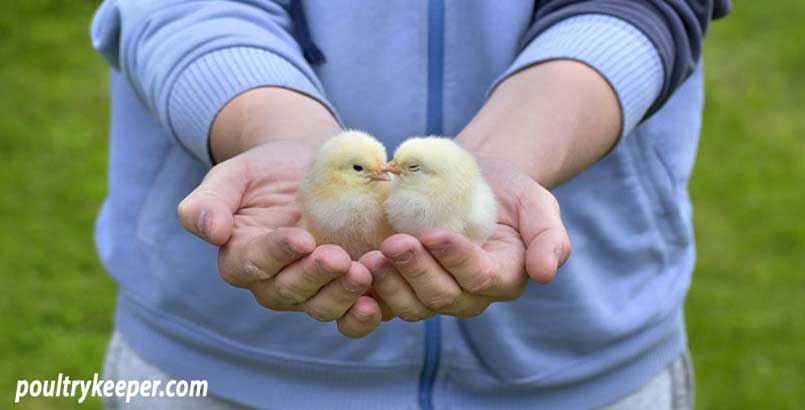
In this article, I look at how to feed chicks from day-old to 18 weeks or point-of-lay, when there is no Mother Hen to care for them. I also provide some ideas for introducing treats and giving tips for feeding chicks in an emergency if you run out of chick crumbs.
Feeding Chickens Series:
Nutritional needs of chickens change with age, there are two articles in our feeding series:
- Feeding Chicks (this article) - From day-old to eighteen weeks old/the point of lay.
- Feeding Chickens - What to feed chickens from eighteen weeks/the point of lay.
Mother Nature is marvellous: before a chick hatches, it will absorb the yolk sac, full of lipids. This allows it to survive a day or more without food or water.
During natural incubation, this buys the chick some time while the remaining eggs in the nest hatch. After this, Mother Hen leads her chicks away from the nest to find food and water.
Hatcheries use this to their advantage. They can ship chicks in boxes around the country without food or water by sending them immediately after hatching. The chicks survive on the nutrients they have absorbed from the yolk sac.
How chicks learn to feed from their mother
When chicks start to explore for food for the first time, they don’t instinctively know which foods are edible and peck at any small objects.
Chicks rely on their mother to teach them what is appropriate to eat by giving them social cues. These are vocal (clucking) and visual (picking up small pieces of food and dropping it again), which say “this is good to eat”.
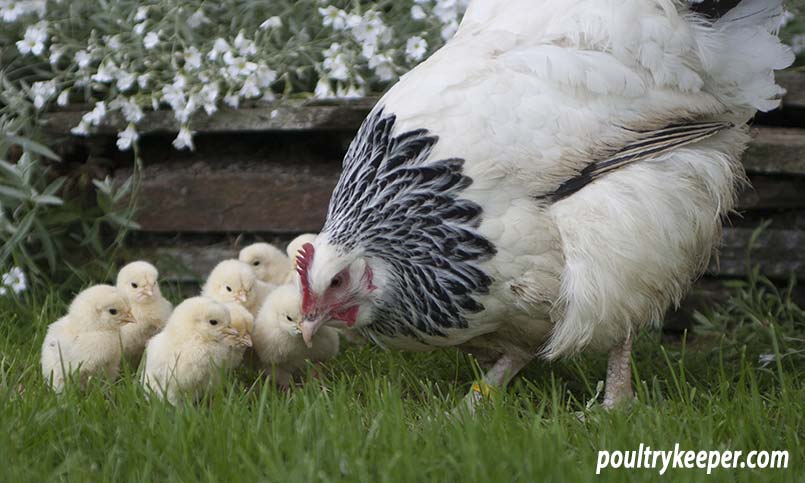
You may even notice the intensity of these signals varies according to how good the food is, so if you put something new and tasty into the run, she will make a lot of fuss to direct the chicks to it.
When chicks find something inappropriate to eat, she may make a different “brrrr” noise, walking off, clucking elsewhere to redirect her chicks.
As a chick develops, this feeding behaviour becomes imprinted, until eventually, after a few weeks, her chicks can go out on their own and ‘instinctively’ know what’s good to eat.
Feeding chicks without Mother Hen
From hatch to five weeks
When we hatch chicks artificially, day-old chicks don’t have a mother to teach them what’s good to eat, so how do they learn to feed?
Firstly, we have to ensure that there is nothing unsuitable for them to eat in the brooder.
It is common to use wood shavings on the brooder’s floor, but I prefer not to do this until they have started eating, or they will peck and eat these. I usually wait until chicks are at least a week old.
An old towel on the brooder floor works well for the first few days, and old newspapers are useful too, but keep an eye out for chicks slipping (which can cause spraddled legs).
Chick Crumbs
Place some chick crumbs in a narrow-lipped chick feeder. These usually have a red coloured base because chickens are attracted to the colour red.
I don’t try to economise by buying cheap chick crumbs. Chicks are completely reliant on the nutrients provided by this food. If they don’t have sufficient nutrients, they will be more prone to disease.
It is more costly in the long run if you have losses!
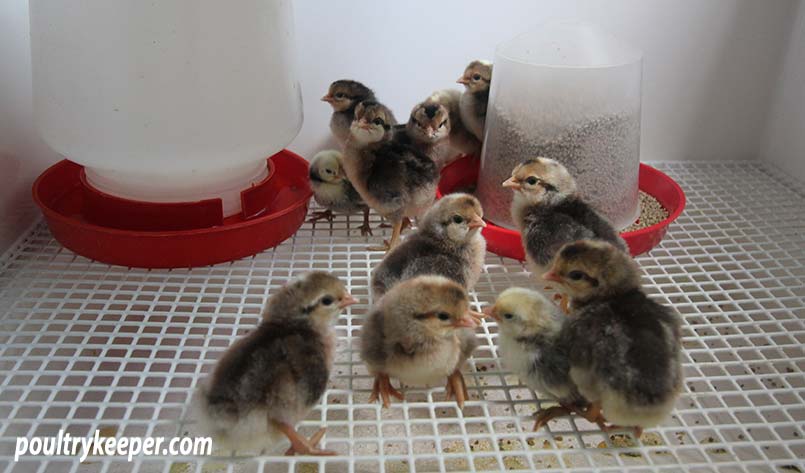
I particularly like Fancy Feeds chick crumbs. I have always found my chicks do well on these; however, I have used Allen & Page, Smallholder Feeds and Dodson & Horrell. They are all high quality feeds suitable for feeding chicks purchased in 5 or 20Kg bags.
Day-old chicks copy other chicks’ behaviour, so once a couple of them start eating, others will soon follow.
You can place some chicks near a feeder and ‘peck’ the crumb using your finger. It will often generate enough interest to get one or two to try the crumb.
Don’t worry if your chicks don’t start feeding; if left with nothing else to try pecking, it won’t be long before they start.
Chicks slow to start feeding?
Remember, chicks will not usually begin feeding on the day they hatch because they have sufficient nutrients from the yolk sac that was absorbed just before hatching.
Quick questions
Feed chick crumbs for the first five weeks.
As your chicks grow, they will consume more and more crumb. By five weeks of age, they will be wasting some of what you feed, and you will need to start changing their feed over to a growers pellet by gradually mixing them in with the crumbs.
By six or seven weeks of age, you should be feeding chicks with growers pellets. These are lower in protein.
If you don’t have chick crumbs, never feed layers pellets.
These are high in calcium (needed to produce eggshells) and can damage a chick’s kidneys. As an emergency feed, mashed hard-boiled eggs are the best choice. Poultry keepers fed hard-boiled eggs to chicks in days gone by before companies developed formulated feeds.
Chick crumbs are a complete feed; you don’t have to provide anything except drinking water. They are high in protein to promote growth and contain processed grains, vitamins and minerals that a chick needs.
As chicks grow, you can introduce some treats. Greens such as cabbage leaves will keep them active, especially if you hang them slightly above their head-height, so they need to jump to reach them. Even a handful of grass is appreciated but quickly wilts in the heat of the brooder.
One fancier I met told me his secret to success was sprouting wheat on a tray and feeding it to his chicks.
A small amount of chopped fruit (such as a quarter of an apple or pear) is also popular.
Medicated chick crumbs
Feeds containing ACS
Some chick crumbs are medicated, containing a coccidiostat to prevent coccidiosis. Check the label; it will say “Medicated feed” or “Contains ACS”, which is short for anti-coccidiostat, a feed additive/drug used to prevent coccidiosis in chicks.
I don’t usually use medicated feeds, but they can be useful in warm/humid conditions or if you’re brooding a lot of batches of chicks in the same brooder.
Medicated chick crumbs and waterfowl
Don't ever feed medicated chick crumbs to waterfowl. They consume more than chicks, resulting in an overdose. They will go off their feet (and eventually die)...
If you keep bedding dry and clean well in between batches, you should be able to minimise problems.
There is also some resistance to medicated feeds, so their effectiveness is questionable when feeding chicks.
What to feed chicks in an emergency
If you run out of chick crumbs...
If you run out of chick crumbs, the best alternative for feeding chicks is a mashed hard-boiled egg.
If you don’t have eggs (in a real, real emergency!), mixed corn, ground with a pestle and mortar can be used. It doesn’t contain sufficient protein, vitamins or minerals, so only use this mixture for a short time until you can get more chick crumbs or hard-boiled eggs.
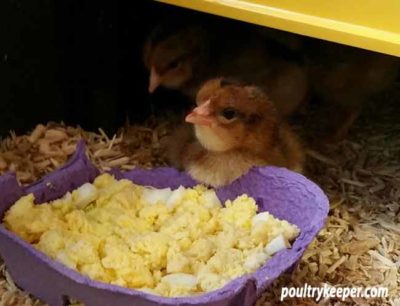
If you feed chicks grains like this, provide chick grit (insoluble flint grit, not soluble oyster shell grit) for digestion.
The hard-boiled egg option is the best short term feed for chicks if you don’t have chick crumbs.
Chick grit
Chickens need insoluble flint grit to digest some of their food correctly. Free-range chickens will pick most of this up themselves (although there are some soil types where they can’t find enough).
Chicks are no exception and need grit, but not until they start eating foods other than chick crumbs or growers pellets.
If you provide your chicks with any food other than chick crumbs or growers pellets, you will need to provide a small container of chick grit so they can digest their food correctly.
Other useful articles & guides:
- Flint Grit and Oystershell Grit for Chickens - Learn about poultry grit.
- Raising Chicks - A guide to setting up a brooder to raise your chicks.
- Feeding Chickens - What to feed chickens over 18 weeks of age.
- Raising Broiler Chickens - If you're raising chickens for the table.
Once my chicks are fully feathered and off heat (at about five to six weeks old), if the weather isn’t too cold, I get them outside onto grass in a portable house and run that I can move daily. Feeding chicks outside will mean you’ll need a waterproof feed container.
For the first few nights, you will need to put them into their house. They will huddle up in a group to keep warm.
Once outdoors, they will eat some grass (new spring grass has some protein), and they pick up grit as they go, but you can still provide some hanging greens and other treats for them.
Feeding growing chicks or 'growers'
From five to eighteen weeks
By five weeks of age, most chicks are fully feathered and big enough to eat “poultry growers pellets”.
You will be able to start mixing these in with their crumbs and gradually change their diet over a week or two. I usually begin to introduce growers pellets at five weeks and stop feeding chick crumbs at about six weeks, sometimes a little longer if I’m using up a bag.
It is common for us to call these older chicks ‘growers’ between 6 and 18 weeks.
After eighteen weeks, they will be ‘cockerels’ (males under one year of age) and ‘pullets’ (females under one year of age).
Pullets at the point of lay (POL) will start laying eggs somewhere between 19 and 25 weeks old, depending on their breed; however, they need enough daylight hours to start laying eggs.
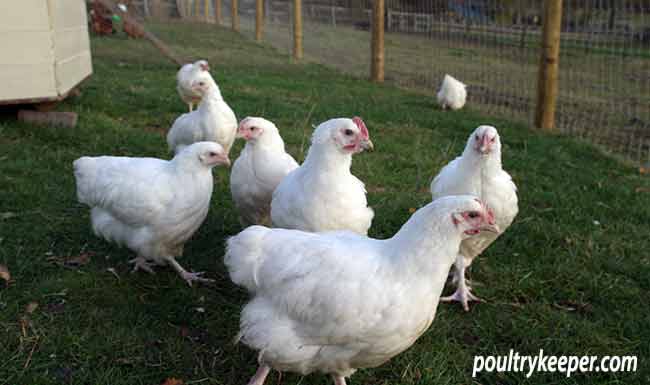
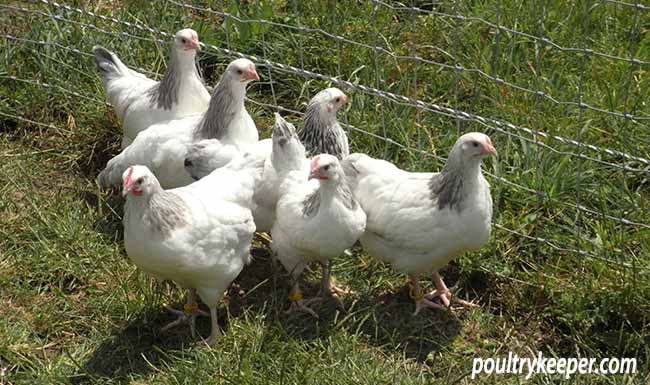
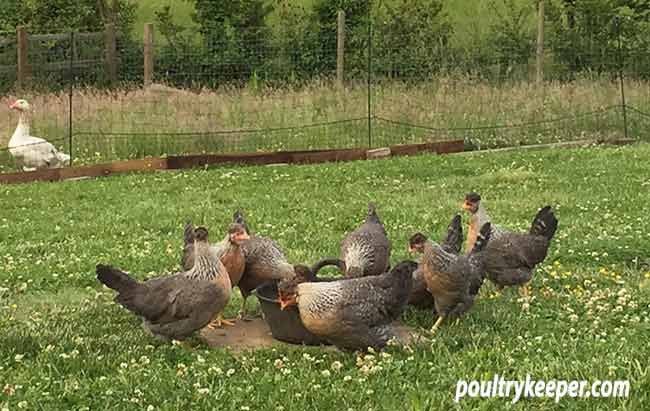
It is possible to use artificial light to bring them in to lay; however, I do not recommend this unless you are really confident that your pullets have fully matured because they will stop growing when they start to lay. If they aren’t fully mature, they will lay smaller eggs.
Keep in mind that large fowl take longer to mature and to reach the point of lay.
Poultry growers pellets
Poultry growers pellets are a complete feed that, as well as being bigger to swallow and in pellet form, matches these growing chickens’ nutritional requirements.
It has a slightly lower protein level and contains an amino acid called methionine or cysteine that builds proteins for adult feather formation and the vitamins and minerals for their overall health.

Medicated feed
Some growers pellets are medicated (with the same drugs found in medicated chick crumbs- see my note about medicated feeds above). If you choose to use medicated growers pellets, remember you must not eat your pullet’s eggs until after a withdrawal period. Check the back of the bag; it’s usually about seven days.
When to change to layers pellets
As your growers mature and reach the point of lay, or even as you start to find the first eggs, change their ration over to layers pellets. Different breeds of hen will require different times to reach maturity; some larger pure breeds can take up to 24 or 25 weeks.
Eggs contain protein, and nearly all of this comes from the diet. Many newcomers ask me when their chickens will start laying (and they will try to encourage them to lay). I always tell them to be patient and wait a few more weeks because they need the protein for growth, and once they start laying, they will use their dietary protein for eggs and stop growing.
Layers pellets contain enough protein for egg production and calcium for producing strong eggshells, which are mostly calcium carbonate.
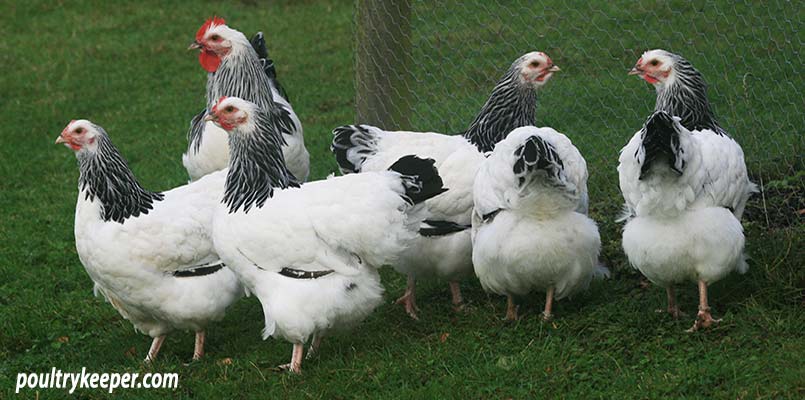
Don’t be tempted to switch to layers pellets too soon since the high calcium levels can cause kidney damage (urolithiasis) and leg problems in growing pullets. You can change to layers pellets at 19 weeks, but I prefer to wait a little longer, especially if my pullets are summer-hatched and won’t start laying until the following spring.
You can tell when pullets will start laying because their combs will start to turn from pink to a deep red.
I hope this article on feeding chicks has been useful to you. Feel free to leave me a comment below!

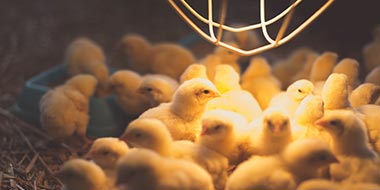
Social cues